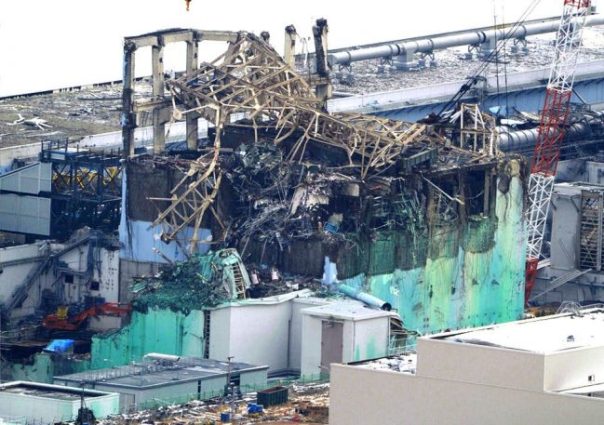As the Midwest experiences unprecedented flooding, authorities assure us that a handful of nuclear power plants in the area will remain at full power and are not in danger. Flooding would be a disaster for a nuclear plant, as it could shut down cooling systems. In a very stormy situation, power to a nuclear plant, necessary to keep cooling systems going while the plant is experiencing an emergency shut down, could be interrupted, and flooding could then damage local petrolium based generators designed to keep the cooling pumps going.
Or course, it is impossible to imagine a nuclear power plant being built in such a way, or in such a place, or maintained in such a way, that mere flooding from excessive rain and a few dam or levy breaks, could threaten it. The nuclear plants are not built by idiots, and the regulatory agencies are very good at overseeing the whole process.

… um … ok, well, to continue…
Dr. Greg Jaczko served on US Representative Ed Markey’s staff as a science fellow, and taught Georgetown University. He served as Senatory Harry Reid’s science advisor, and in other roles for the US Senate. He became a commisioner of the Nuclear Regulatory Commission (NRC) early in January 20905, andwas appointed by President Obama, in 2009, to chair that body.
 His philosophy as a regulator has been transparency and public participation. He worked to improve security regulations for nuclear plants, and oversaw the initiative to make these plants airplane strike resistant. He is most well known for taking the lessons of the Fukushima nuclear disaster into account when considering further development in American nuclear energy. He took a role in stopping plans for the development of the Yucca Mountain repository. He is responsible for stopping plans for the Southern Co to build new reactors at the Vogtle plant in Georgia.
His philosophy as a regulator has been transparency and public participation. He worked to improve security regulations for nuclear plants, and oversaw the initiative to make these plants airplane strike resistant. He is most well known for taking the lessons of the Fukushima nuclear disaster into account when considering further development in American nuclear energy. He took a role in stopping plans for the development of the Yucca Mountain repository. He is responsible for stopping plans for the Southern Co to build new reactors at the Vogtle plant in Georgia.
His time as commissioner and head of the NRC is not without controversy. There are complaints about his management style, and women who worked with him claim to have been treated in a more demeaning manner than their male counterparts. Jaczko’s response to these complains has been to cite a conspiracy by pro-nuclear forces against him, because of his lack of blind support for the industry. This position, that the pro-nukers have unfairly treated Jaczko, is supported by a number of third party individuals. He was asked to resign before the end of his term, but claims that this was a strategy of Senator Reid’s, to have control over who the next appointee would be.
I have no fully formed opinion on this, but I suspect that a pro-regulation regulator in Washington is essentially pre-doomed, because most of the regulatory agencies have been taken over by the industries they regulate.
Anyway, Jaczko wrote a book, and it is a rollicking, interesting, disturbing, and important read. Confessions of a Rogue Nuclear Regulator is the Jaczko story told by Jaczko.
If Jaczko is legit, if the points he is pushing are valid, then we should expect pushback from surrogates supportive of the nuclear industry in response to the book. That of course happened. I have no intention of getting into an internet fight with the greenwashers, but if you scan for reviews of Confessions of a Rogue Nuclear Regulator, you’ll find greenish pro nukers writing negative ones in widely read outlets. At the same time, the book is “liked” in the reviews by both independent thinking science reviewers and the usual anti-nuclear activists.
The book is an engaging and fast read, important, and you should judge for yourself.



 The relationship between rainfall, groundwater, evaporation and transpiration, vegetation, bodies of water, animal distribution, agriculture, humans, and atmospheric conditions (not to mention oceanic factors and topography) underlie many different realms of academia and policy. Almost nothing I’ve ever done in my anthropological research didn’t include the hydrologic cycle, climate, and related issues. The weather weirding we are currently watching across the globe, including the current heavy rains and tornadoes, are part of this, and the long lived California Drought, the one that ended just recently, is as well.
The relationship between rainfall, groundwater, evaporation and transpiration, vegetation, bodies of water, animal distribution, agriculture, humans, and atmospheric conditions (not to mention oceanic factors and topography) underlie many different realms of academia and policy. Almost nothing I’ve ever done in my anthropological research didn’t include the hydrologic cycle, climate, and related issues. The weather weirding we are currently watching across the globe, including the current heavy rains and tornadoes, are part of this, and the long lived California Drought, the one that ended just recently, is as well.










 I am especially attracted to science or technology books that contain something the reader can work with. A book about a programming language should walk the reader through developing a good example of useful code. A book about computational science should include templates for workflow in data analysis. It is rare, though, to find a book about a pure science (as opposed to technology) that does this.
I am especially attracted to science or technology books that contain something the reader can work with. A book about a programming language should walk the reader through developing a good example of useful code. A book about computational science should include templates for workflow in data analysis. It is rare, though, to find a book about a pure science (as opposed to technology) that does this. 